Importance of Employee Relations in HRM Decision-Making
VerifiedAdded on 2023/01/19
|13
|3766
|92
AI Summary
This article analyzes the importance of employee relations in influencing HRM decision-making and its impact on organizational productivity and profit. It discusses strategies for managing employee relations and the stages of HRM decision-making.
Contribute Materials
Your contribution can guide someone’s learning journey. Share your
documents today.

Human Resource
Management
Management
Secure Best Marks with AI Grader
Need help grading? Try our AI Grader for instant feedback on your assignments.
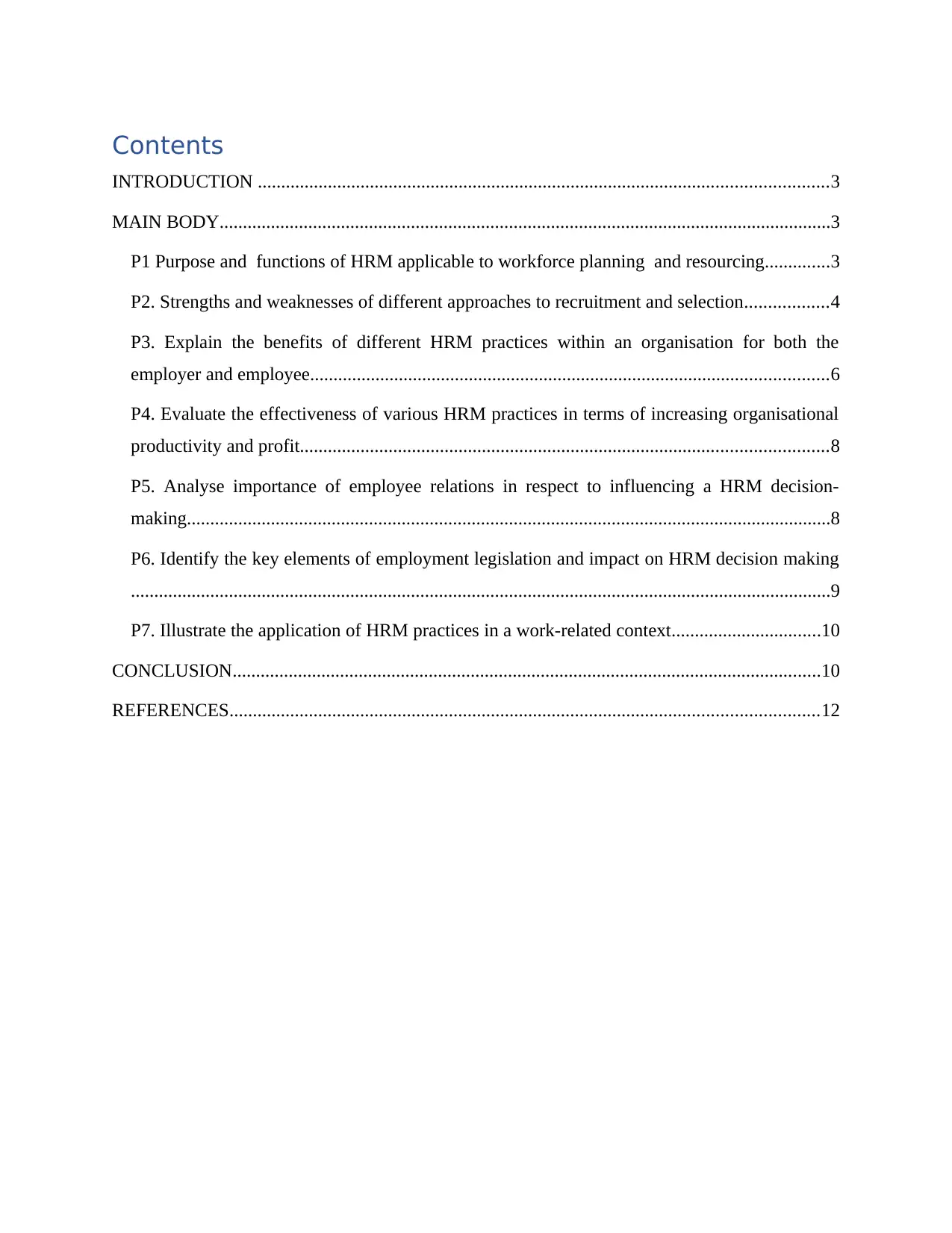
Contents
INTRODUCTION ..........................................................................................................................3
MAIN BODY...................................................................................................................................3
P1 Purpose and functions of HRM applicable to workforce planning and resourcing..............3
P2. Strengths and weaknesses of different approaches to recruitment and selection..................4
P3. Explain the benefits of different HRM practices within an organisation for both the
employer and employee...............................................................................................................6
P4. Evaluate the effectiveness of various HRM practices in terms of increasing organisational
productivity and profit.................................................................................................................8
P5. Analyse importance of employee relations in respect to influencing a HRM decision-
making..........................................................................................................................................8
P6. Identify the key elements of employment legislation and impact on HRM decision making
......................................................................................................................................................9
P7. Illustrate the application of HRM practices in a work-related context................................10
CONCLUSION..............................................................................................................................10
REFERENCES..............................................................................................................................12
INTRODUCTION ..........................................................................................................................3
MAIN BODY...................................................................................................................................3
P1 Purpose and functions of HRM applicable to workforce planning and resourcing..............3
P2. Strengths and weaknesses of different approaches to recruitment and selection..................4
P3. Explain the benefits of different HRM practices within an organisation for both the
employer and employee...............................................................................................................6
P4. Evaluate the effectiveness of various HRM practices in terms of increasing organisational
productivity and profit.................................................................................................................8
P5. Analyse importance of employee relations in respect to influencing a HRM decision-
making..........................................................................................................................................8
P6. Identify the key elements of employment legislation and impact on HRM decision making
......................................................................................................................................................9
P7. Illustrate the application of HRM practices in a work-related context................................10
CONCLUSION..............................................................................................................................10
REFERENCES..............................................................................................................................12
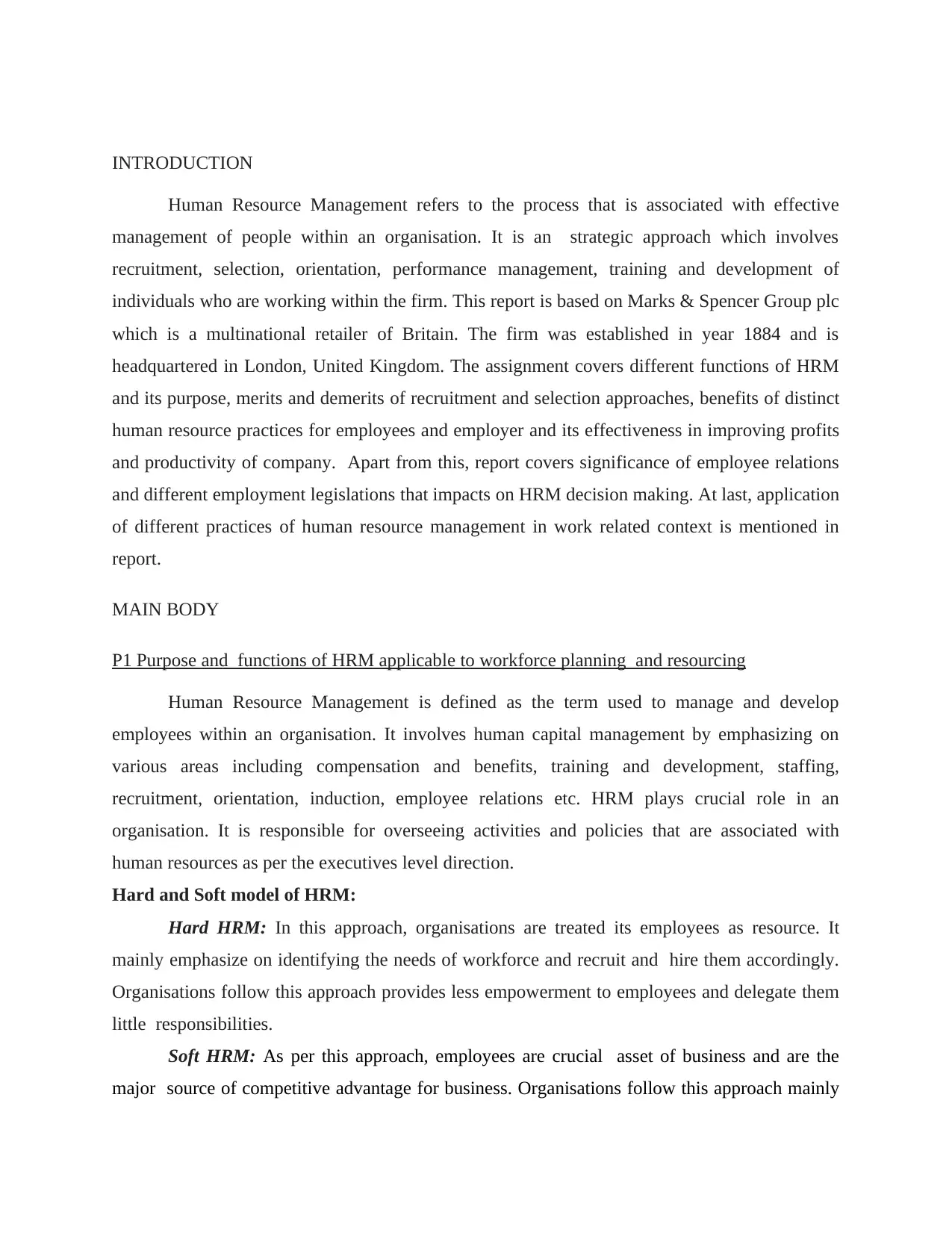
INTRODUCTION
Human Resource Management refers to the process that is associated with effective
management of people within an organisation. It is an strategic approach which involves
recruitment, selection, orientation, performance management, training and development of
individuals who are working within the firm. This report is based on Marks & Spencer Group plc
which is a multinational retailer of Britain. The firm was established in year 1884 and is
headquartered in London, United Kingdom. The assignment covers different functions of HRM
and its purpose, merits and demerits of recruitment and selection approaches, benefits of distinct
human resource practices for employees and employer and its effectiveness in improving profits
and productivity of company. Apart from this, report covers significance of employee relations
and different employment legislations that impacts on HRM decision making. At last, application
of different practices of human resource management in work related context is mentioned in
report.
MAIN BODY
P1 Purpose and functions of HRM applicable to workforce planning and resourcing
Human Resource Management is defined as the term used to manage and develop
employees within an organisation. It involves human capital management by emphasizing on
various areas including compensation and benefits, training and development, staffing,
recruitment, orientation, induction, employee relations etc. HRM plays crucial role in an
organisation. It is responsible for overseeing activities and policies that are associated with
human resources as per the executives level direction.
Hard and Soft model of HRM:
Hard HRM: In this approach, organisations are treated its employees as resource. It
mainly emphasize on identifying the needs of workforce and recruit and hire them accordingly.
Organisations follow this approach provides less empowerment to employees and delegate them
little responsibilities.
Soft HRM: As per this approach, employees are crucial asset of business and are the
major source of competitive advantage for business. Organisations follow this approach mainly
Human Resource Management refers to the process that is associated with effective
management of people within an organisation. It is an strategic approach which involves
recruitment, selection, orientation, performance management, training and development of
individuals who are working within the firm. This report is based on Marks & Spencer Group plc
which is a multinational retailer of Britain. The firm was established in year 1884 and is
headquartered in London, United Kingdom. The assignment covers different functions of HRM
and its purpose, merits and demerits of recruitment and selection approaches, benefits of distinct
human resource practices for employees and employer and its effectiveness in improving profits
and productivity of company. Apart from this, report covers significance of employee relations
and different employment legislations that impacts on HRM decision making. At last, application
of different practices of human resource management in work related context is mentioned in
report.
MAIN BODY
P1 Purpose and functions of HRM applicable to workforce planning and resourcing
Human Resource Management is defined as the term used to manage and develop
employees within an organisation. It involves human capital management by emphasizing on
various areas including compensation and benefits, training and development, staffing,
recruitment, orientation, induction, employee relations etc. HRM plays crucial role in an
organisation. It is responsible for overseeing activities and policies that are associated with
human resources as per the executives level direction.
Hard and Soft model of HRM:
Hard HRM: In this approach, organisations are treated its employees as resource. It
mainly emphasize on identifying the needs of workforce and recruit and hire them accordingly.
Organisations follow this approach provides less empowerment to employees and delegate them
little responsibilities.
Soft HRM: As per this approach, employees are crucial asset of business and are the
major source of competitive advantage for business. Organisations follow this approach mainly
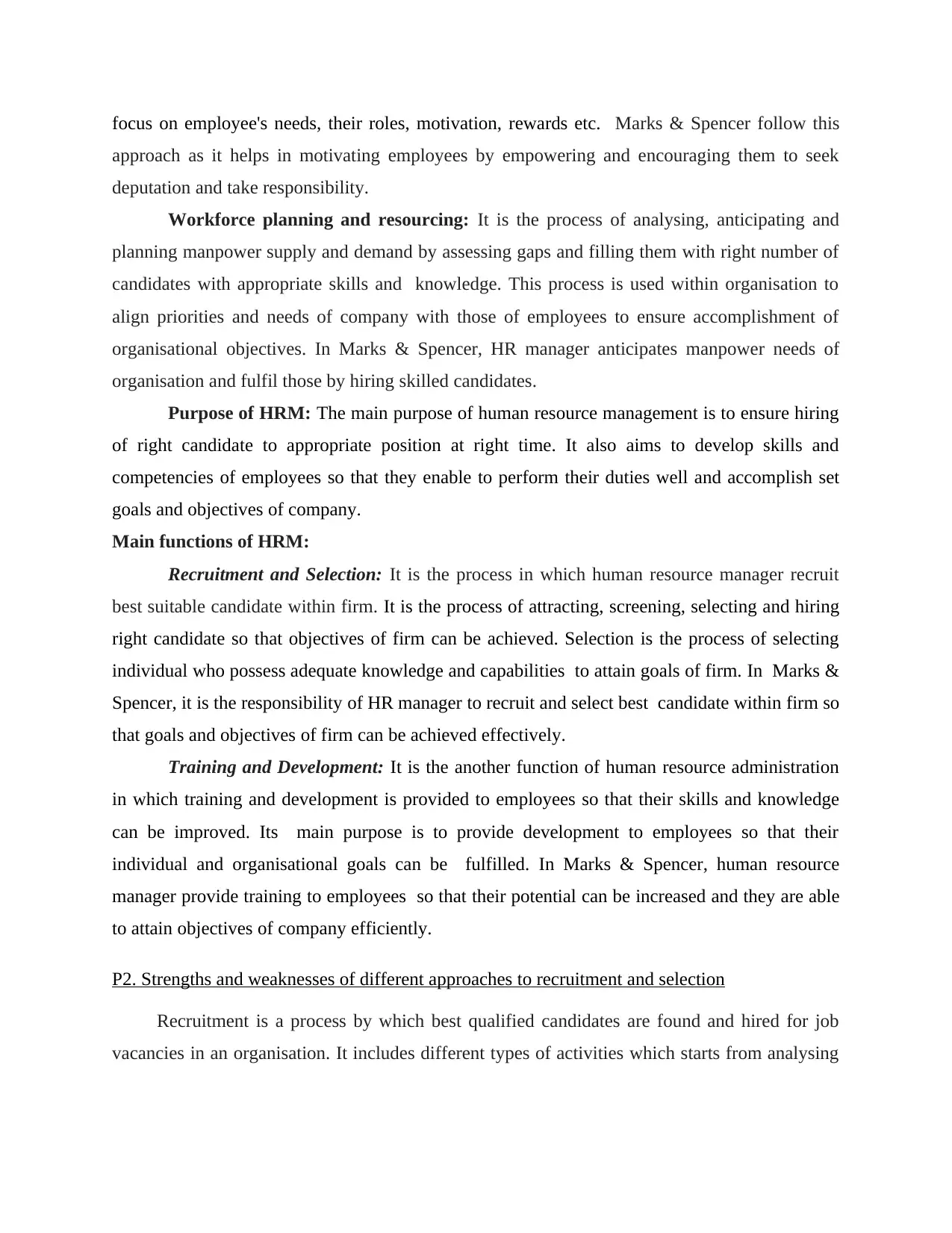
focus on employee's needs, their roles, motivation, rewards etc. Marks & Spencer follow this
approach as it helps in motivating employees by empowering and encouraging them to seek
deputation and take responsibility.
Workforce planning and resourcing: It is the process of analysing, anticipating and
planning manpower supply and demand by assessing gaps and filling them with right number of
candidates with appropriate skills and knowledge. This process is used within organisation to
align priorities and needs of company with those of employees to ensure accomplishment of
organisational objectives. In Marks & Spencer, HR manager anticipates manpower needs of
organisation and fulfil those by hiring skilled candidates.
Purpose of HRM: The main purpose of human resource management is to ensure hiring
of right candidate to appropriate position at right time. It also aims to develop skills and
competencies of employees so that they enable to perform their duties well and accomplish set
goals and objectives of company.
Main functions of HRM:
Recruitment and Selection: It is the process in which human resource manager recruit
best suitable candidate within firm. It is the process of attracting, screening, selecting and hiring
right candidate so that objectives of firm can be achieved. Selection is the process of selecting
individual who possess adequate knowledge and capabilities to attain goals of firm. In Marks &
Spencer, it is the responsibility of HR manager to recruit and select best candidate within firm so
that goals and objectives of firm can be achieved effectively.
Training and Development: It is the another function of human resource administration
in which training and development is provided to employees so that their skills and knowledge
can be improved. Its main purpose is to provide development to employees so that their
individual and organisational goals can be fulfilled. In Marks & Spencer, human resource
manager provide training to employees so that their potential can be increased and they are able
to attain objectives of company efficiently.
P2. Strengths and weaknesses of different approaches to recruitment and selection
Recruitment is a process by which best qualified candidates are found and hired for job
vacancies in an organisation. It includes different types of activities which starts from analysing
approach as it helps in motivating employees by empowering and encouraging them to seek
deputation and take responsibility.
Workforce planning and resourcing: It is the process of analysing, anticipating and
planning manpower supply and demand by assessing gaps and filling them with right number of
candidates with appropriate skills and knowledge. This process is used within organisation to
align priorities and needs of company with those of employees to ensure accomplishment of
organisational objectives. In Marks & Spencer, HR manager anticipates manpower needs of
organisation and fulfil those by hiring skilled candidates.
Purpose of HRM: The main purpose of human resource management is to ensure hiring
of right candidate to appropriate position at right time. It also aims to develop skills and
competencies of employees so that they enable to perform their duties well and accomplish set
goals and objectives of company.
Main functions of HRM:
Recruitment and Selection: It is the process in which human resource manager recruit
best suitable candidate within firm. It is the process of attracting, screening, selecting and hiring
right candidate so that objectives of firm can be achieved. Selection is the process of selecting
individual who possess adequate knowledge and capabilities to attain goals of firm. In Marks &
Spencer, it is the responsibility of HR manager to recruit and select best candidate within firm so
that goals and objectives of firm can be achieved effectively.
Training and Development: It is the another function of human resource administration
in which training and development is provided to employees so that their skills and knowledge
can be improved. Its main purpose is to provide development to employees so that their
individual and organisational goals can be fulfilled. In Marks & Spencer, human resource
manager provide training to employees so that their potential can be increased and they are able
to attain objectives of company efficiently.
P2. Strengths and weaknesses of different approaches to recruitment and selection
Recruitment is a process by which best qualified candidates are found and hired for job
vacancies in an organisation. It includes different types of activities which starts from analysing
Secure Best Marks with AI Grader
Need help grading? Try our AI Grader for instant feedback on your assignments.
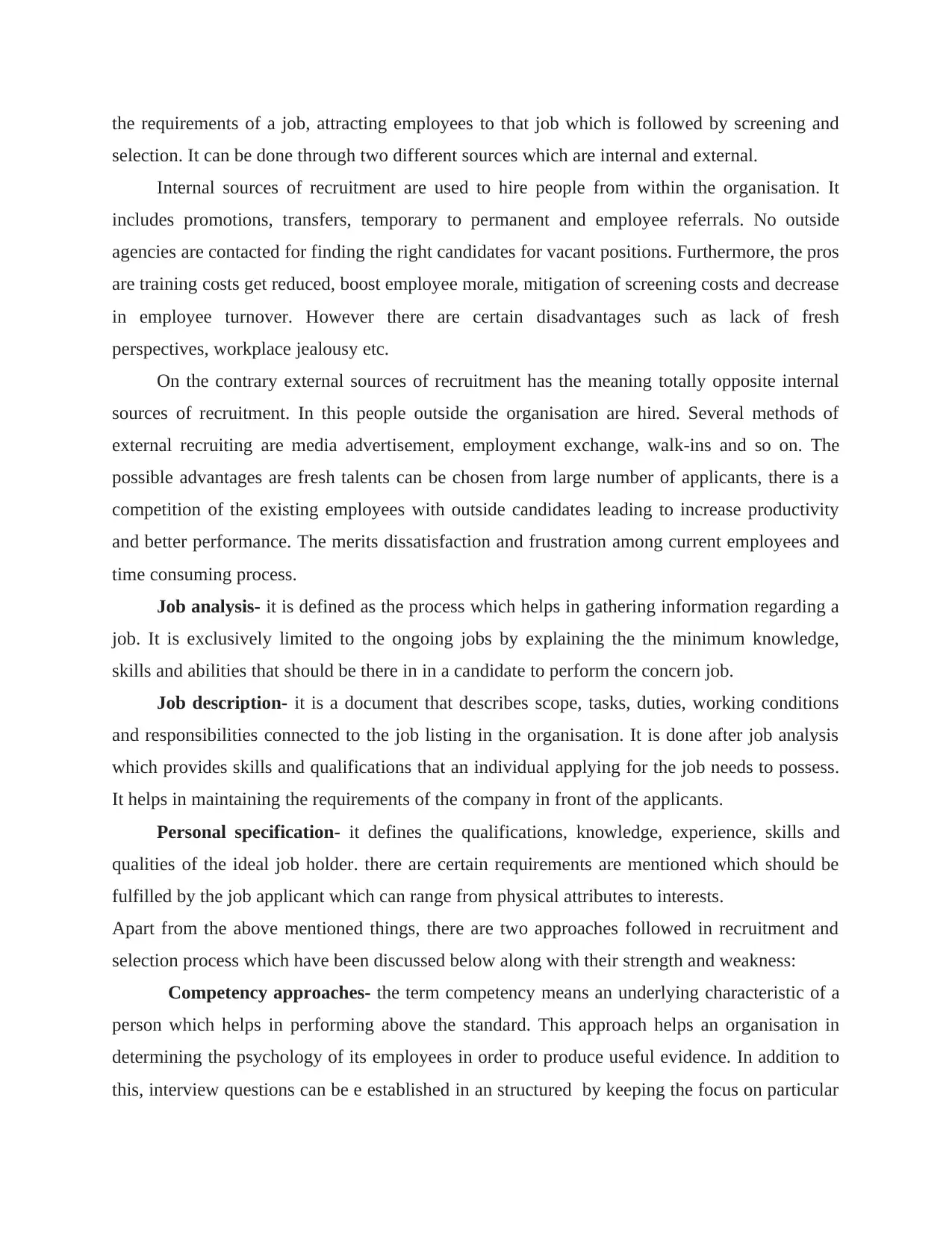
the requirements of a job, attracting employees to that job which is followed by screening and
selection. It can be done through two different sources which are internal and external.
Internal sources of recruitment are used to hire people from within the organisation. It
includes promotions, transfers, temporary to permanent and employee referrals. No outside
agencies are contacted for finding the right candidates for vacant positions. Furthermore, the pros
are training costs get reduced, boost employee morale, mitigation of screening costs and decrease
in employee turnover. However there are certain disadvantages such as lack of fresh
perspectives, workplace jealousy etc.
On the contrary external sources of recruitment has the meaning totally opposite internal
sources of recruitment. In this people outside the organisation are hired. Several methods of
external recruiting are media advertisement, employment exchange, walk-ins and so on. The
possible advantages are fresh talents can be chosen from large number of applicants, there is a
competition of the existing employees with outside candidates leading to increase productivity
and better performance. The merits dissatisfaction and frustration among current employees and
time consuming process.
Job analysis- it is defined as the process which helps in gathering information regarding a
job. It is exclusively limited to the ongoing jobs by explaining the the minimum knowledge,
skills and abilities that should be there in in a candidate to perform the concern job.
Job description- it is a document that describes scope, tasks, duties, working conditions
and responsibilities connected to the job listing in the organisation. It is done after job analysis
which provides skills and qualifications that an individual applying for the job needs to possess.
It helps in maintaining the requirements of the company in front of the applicants.
Personal specification- it defines the qualifications, knowledge, experience, skills and
qualities of the ideal job holder. there are certain requirements are mentioned which should be
fulfilled by the job applicant which can range from physical attributes to interests.
Apart from the above mentioned things, there are two approaches followed in recruitment and
selection process which have been discussed below along with their strength and weakness:
Competency approaches- the term competency means an underlying characteristic of a
person which helps in performing above the standard. This approach helps an organisation in
determining the psychology of its employees in order to produce useful evidence. In addition to
this, interview questions can be e established in an structured by keeping the focus on particular
selection. It can be done through two different sources which are internal and external.
Internal sources of recruitment are used to hire people from within the organisation. It
includes promotions, transfers, temporary to permanent and employee referrals. No outside
agencies are contacted for finding the right candidates for vacant positions. Furthermore, the pros
are training costs get reduced, boost employee morale, mitigation of screening costs and decrease
in employee turnover. However there are certain disadvantages such as lack of fresh
perspectives, workplace jealousy etc.
On the contrary external sources of recruitment has the meaning totally opposite internal
sources of recruitment. In this people outside the organisation are hired. Several methods of
external recruiting are media advertisement, employment exchange, walk-ins and so on. The
possible advantages are fresh talents can be chosen from large number of applicants, there is a
competition of the existing employees with outside candidates leading to increase productivity
and better performance. The merits dissatisfaction and frustration among current employees and
time consuming process.
Job analysis- it is defined as the process which helps in gathering information regarding a
job. It is exclusively limited to the ongoing jobs by explaining the the minimum knowledge,
skills and abilities that should be there in in a candidate to perform the concern job.
Job description- it is a document that describes scope, tasks, duties, working conditions
and responsibilities connected to the job listing in the organisation. It is done after job analysis
which provides skills and qualifications that an individual applying for the job needs to possess.
It helps in maintaining the requirements of the company in front of the applicants.
Personal specification- it defines the qualifications, knowledge, experience, skills and
qualities of the ideal job holder. there are certain requirements are mentioned which should be
fulfilled by the job applicant which can range from physical attributes to interests.
Apart from the above mentioned things, there are two approaches followed in recruitment and
selection process which have been discussed below along with their strength and weakness:
Competency approaches- the term competency means an underlying characteristic of a
person which helps in performing above the standard. This approach helps an organisation in
determining the psychology of its employees in order to produce useful evidence. In addition to
this, interview questions can be e established in an structured by keeping the focus on particular
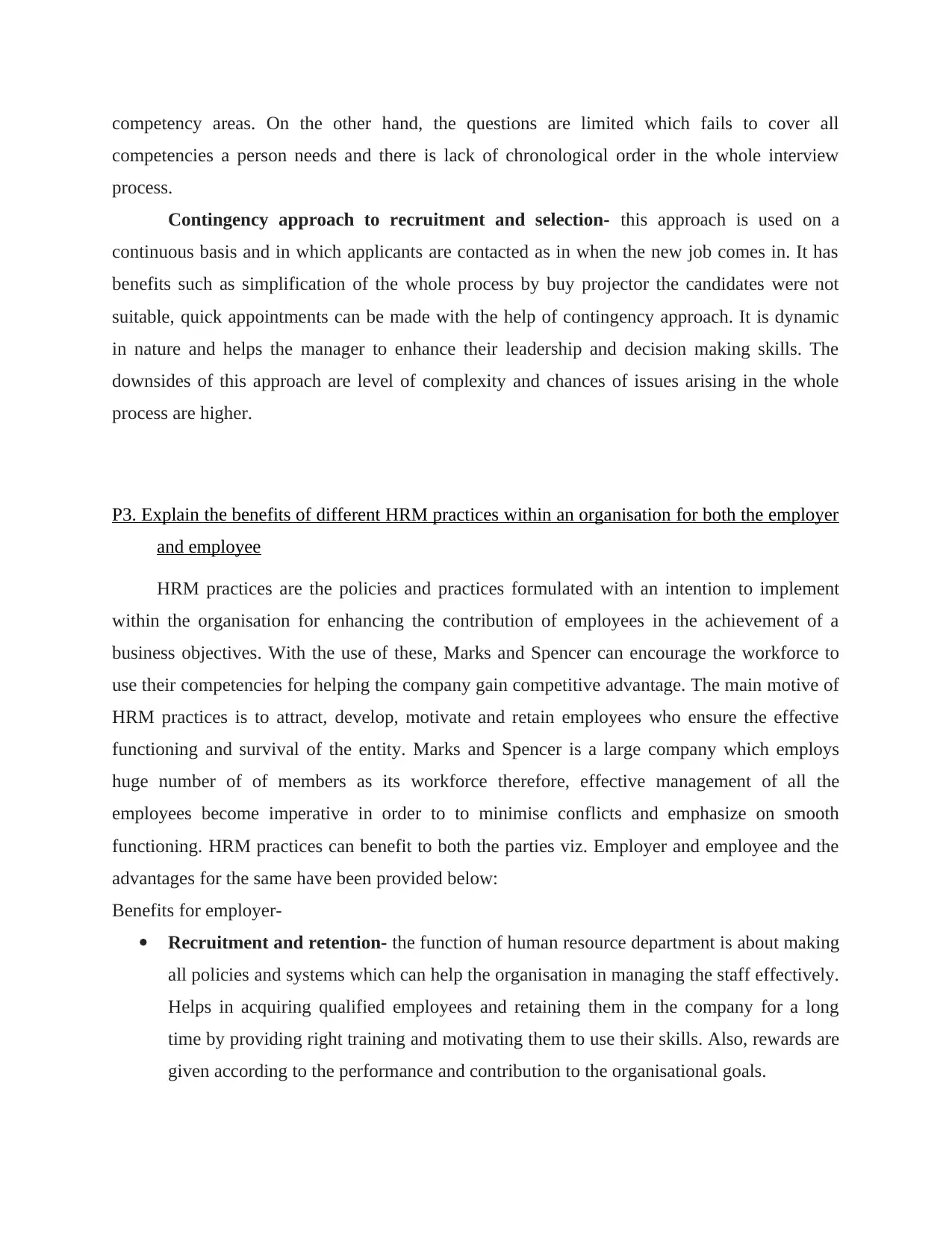
competency areas. On the other hand, the questions are limited which fails to cover all
competencies a person needs and there is lack of chronological order in the whole interview
process.
Contingency approach to recruitment and selection- this approach is used on a
continuous basis and in which applicants are contacted as in when the new job comes in. It has
benefits such as simplification of the whole process by buy projector the candidates were not
suitable, quick appointments can be made with the help of contingency approach. It is dynamic
in nature and helps the manager to enhance their leadership and decision making skills. The
downsides of this approach are level of complexity and chances of issues arising in the whole
process are higher.
P3. Explain the benefits of different HRM practices within an organisation for both the employer
and employee
HRM practices are the policies and practices formulated with an intention to implement
within the organisation for enhancing the contribution of employees in the achievement of a
business objectives. With the use of these, Marks and Spencer can encourage the workforce to
use their competencies for helping the company gain competitive advantage. The main motive of
HRM practices is to attract, develop, motivate and retain employees who ensure the effective
functioning and survival of the entity. Marks and Spencer is a large company which employs
huge number of of members as its workforce therefore, effective management of all the
employees become imperative in order to to minimise conflicts and emphasize on smooth
functioning. HRM practices can benefit to both the parties viz. Employer and employee and the
advantages for the same have been provided below:
Benefits for employer-
Recruitment and retention- the function of human resource department is about making
all policies and systems which can help the organisation in managing the staff effectively.
Helps in acquiring qualified employees and retaining them in the company for a long
time by providing right training and motivating them to use their skills. Also, rewards are
given according to the performance and contribution to the organisational goals.
competencies a person needs and there is lack of chronological order in the whole interview
process.
Contingency approach to recruitment and selection- this approach is used on a
continuous basis and in which applicants are contacted as in when the new job comes in. It has
benefits such as simplification of the whole process by buy projector the candidates were not
suitable, quick appointments can be made with the help of contingency approach. It is dynamic
in nature and helps the manager to enhance their leadership and decision making skills. The
downsides of this approach are level of complexity and chances of issues arising in the whole
process are higher.
P3. Explain the benefits of different HRM practices within an organisation for both the employer
and employee
HRM practices are the policies and practices formulated with an intention to implement
within the organisation for enhancing the contribution of employees in the achievement of a
business objectives. With the use of these, Marks and Spencer can encourage the workforce to
use their competencies for helping the company gain competitive advantage. The main motive of
HRM practices is to attract, develop, motivate and retain employees who ensure the effective
functioning and survival of the entity. Marks and Spencer is a large company which employs
huge number of of members as its workforce therefore, effective management of all the
employees become imperative in order to to minimise conflicts and emphasize on smooth
functioning. HRM practices can benefit to both the parties viz. Employer and employee and the
advantages for the same have been provided below:
Benefits for employer-
Recruitment and retention- the function of human resource department is about making
all policies and systems which can help the organisation in managing the staff effectively.
Helps in acquiring qualified employees and retaining them in the company for a long
time by providing right training and motivating them to use their skills. Also, rewards are
given according to the performance and contribution to the organisational goals.
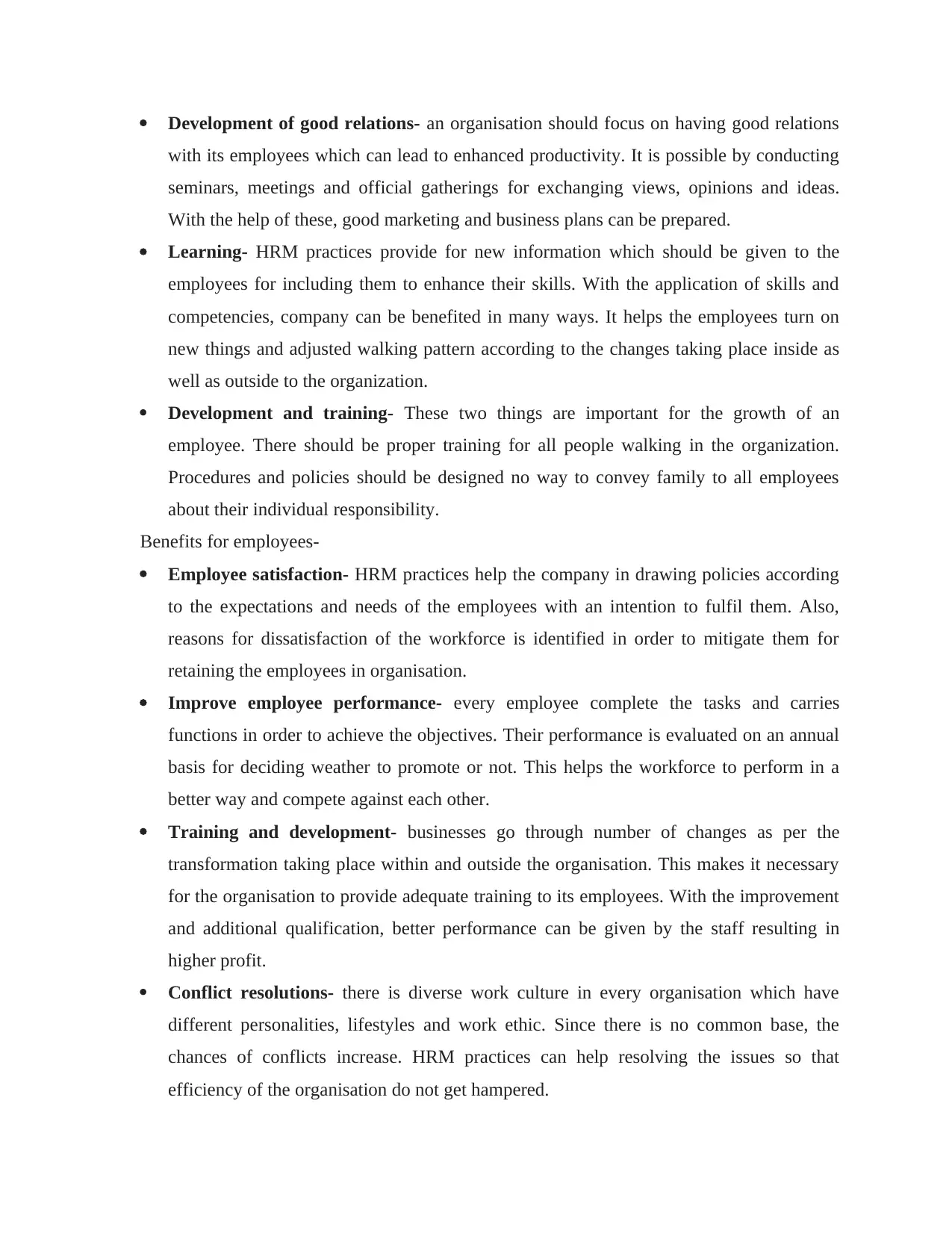
Development of good relations- an organisation should focus on having good relations
with its employees which can lead to enhanced productivity. It is possible by conducting
seminars, meetings and official gatherings for exchanging views, opinions and ideas.
With the help of these, good marketing and business plans can be prepared.
Learning- HRM practices provide for new information which should be given to the
employees for including them to enhance their skills. With the application of skills and
competencies, company can be benefited in many ways. It helps the employees turn on
new things and adjusted walking pattern according to the changes taking place inside as
well as outside to the organization.
Development and training- These two things are important for the growth of an
employee. There should be proper training for all people walking in the organization.
Procedures and policies should be designed no way to convey family to all employees
about their individual responsibility.
Benefits for employees-
Employee satisfaction- HRM practices help the company in drawing policies according
to the expectations and needs of the employees with an intention to fulfil them. Also,
reasons for dissatisfaction of the workforce is identified in order to mitigate them for
retaining the employees in organisation.
Improve employee performance- every employee complete the tasks and carries
functions in order to achieve the objectives. Their performance is evaluated on an annual
basis for deciding weather to promote or not. This helps the workforce to perform in a
better way and compete against each other.
Training and development- businesses go through number of changes as per the
transformation taking place within and outside the organisation. This makes it necessary
for the organisation to provide adequate training to its employees. With the improvement
and additional qualification, better performance can be given by the staff resulting in
higher profit.
Conflict resolutions- there is diverse work culture in every organisation which have
different personalities, lifestyles and work ethic. Since there is no common base, the
chances of conflicts increase. HRM practices can help resolving the issues so that
efficiency of the organisation do not get hampered.
with its employees which can lead to enhanced productivity. It is possible by conducting
seminars, meetings and official gatherings for exchanging views, opinions and ideas.
With the help of these, good marketing and business plans can be prepared.
Learning- HRM practices provide for new information which should be given to the
employees for including them to enhance their skills. With the application of skills and
competencies, company can be benefited in many ways. It helps the employees turn on
new things and adjusted walking pattern according to the changes taking place inside as
well as outside to the organization.
Development and training- These two things are important for the growth of an
employee. There should be proper training for all people walking in the organization.
Procedures and policies should be designed no way to convey family to all employees
about their individual responsibility.
Benefits for employees-
Employee satisfaction- HRM practices help the company in drawing policies according
to the expectations and needs of the employees with an intention to fulfil them. Also,
reasons for dissatisfaction of the workforce is identified in order to mitigate them for
retaining the employees in organisation.
Improve employee performance- every employee complete the tasks and carries
functions in order to achieve the objectives. Their performance is evaluated on an annual
basis for deciding weather to promote or not. This helps the workforce to perform in a
better way and compete against each other.
Training and development- businesses go through number of changes as per the
transformation taking place within and outside the organisation. This makes it necessary
for the organisation to provide adequate training to its employees. With the improvement
and additional qualification, better performance can be given by the staff resulting in
higher profit.
Conflict resolutions- there is diverse work culture in every organisation which have
different personalities, lifestyles and work ethic. Since there is no common base, the
chances of conflicts increase. HRM practices can help resolving the issues so that
efficiency of the organisation do not get hampered.
Paraphrase This Document
Need a fresh take? Get an instant paraphrase of this document with our AI Paraphraser
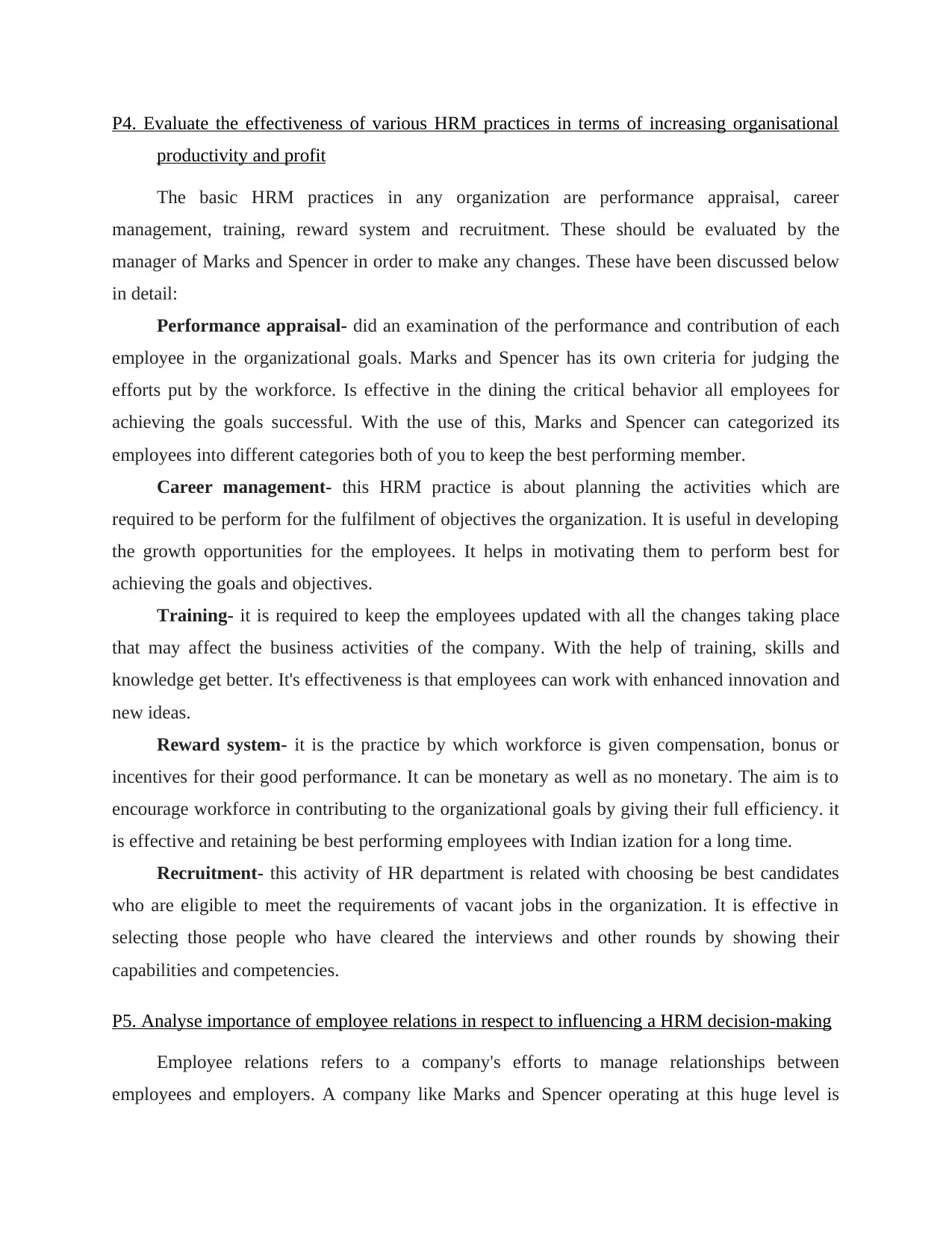
P4. Evaluate the effectiveness of various HRM practices in terms of increasing organisational
productivity and profit
The basic HRM practices in any organization are performance appraisal, career
management, training, reward system and recruitment. These should be evaluated by the
manager of Marks and Spencer in order to make any changes. These have been discussed below
in detail:
Performance appraisal- did an examination of the performance and contribution of each
employee in the organizational goals. Marks and Spencer has its own criteria for judging the
efforts put by the workforce. Is effective in the dining the critical behavior all employees for
achieving the goals successful. With the use of this, Marks and Spencer can categorized its
employees into different categories both of you to keep the best performing member.
Career management- this HRM practice is about planning the activities which are
required to be perform for the fulfilment of objectives the organization. It is useful in developing
the growth opportunities for the employees. It helps in motivating them to perform best for
achieving the goals and objectives.
Training- it is required to keep the employees updated with all the changes taking place
that may affect the business activities of the company. With the help of training, skills and
knowledge get better. It's effectiveness is that employees can work with enhanced innovation and
new ideas.
Reward system- it is the practice by which workforce is given compensation, bonus or
incentives for their good performance. It can be monetary as well as no monetary. The aim is to
encourage workforce in contributing to the organizational goals by giving their full efficiency. it
is effective and retaining be best performing employees with Indian ization for a long time.
Recruitment- this activity of HR department is related with choosing be best candidates
who are eligible to meet the requirements of vacant jobs in the organization. It is effective in
selecting those people who have cleared the interviews and other rounds by showing their
capabilities and competencies.
P5. Analyse importance of employee relations in respect to influencing a HRM decision-making
Employee relations refers to a company's efforts to manage relationships between
employees and employers. A company like Marks and Spencer operating at this huge level is
productivity and profit
The basic HRM practices in any organization are performance appraisal, career
management, training, reward system and recruitment. These should be evaluated by the
manager of Marks and Spencer in order to make any changes. These have been discussed below
in detail:
Performance appraisal- did an examination of the performance and contribution of each
employee in the organizational goals. Marks and Spencer has its own criteria for judging the
efforts put by the workforce. Is effective in the dining the critical behavior all employees for
achieving the goals successful. With the use of this, Marks and Spencer can categorized its
employees into different categories both of you to keep the best performing member.
Career management- this HRM practice is about planning the activities which are
required to be perform for the fulfilment of objectives the organization. It is useful in developing
the growth opportunities for the employees. It helps in motivating them to perform best for
achieving the goals and objectives.
Training- it is required to keep the employees updated with all the changes taking place
that may affect the business activities of the company. With the help of training, skills and
knowledge get better. It's effectiveness is that employees can work with enhanced innovation and
new ideas.
Reward system- it is the practice by which workforce is given compensation, bonus or
incentives for their good performance. It can be monetary as well as no monetary. The aim is to
encourage workforce in contributing to the organizational goals by giving their full efficiency. it
is effective and retaining be best performing employees with Indian ization for a long time.
Recruitment- this activity of HR department is related with choosing be best candidates
who are eligible to meet the requirements of vacant jobs in the organization. It is effective in
selecting those people who have cleared the interviews and other rounds by showing their
capabilities and competencies.
P5. Analyse importance of employee relations in respect to influencing a HRM decision-making
Employee relations refers to a company's efforts to manage relationships between
employees and employers. A company like Marks and Spencer operating at this huge level is

required to manage all the employees effectively and fulfill their requirements. This helps in
keeping the relationship healthy and good. Some of these strategies are as follows:
Involve your team members: HR manager should give significant importance to the
employees and encourage them to share their ideas in the decision making.
Sharing of work: every employee should be motivated to share the work with each other
and make decisions on their own.
Equal contribution: every team member should be assigned task and motivation should be
given to work in groups and help the fellow workers by focusing on achieving the common
goals.
Effective communication: it is very important to have communication with each other in
order to understand and remove any confusion. The HR manager should be direct and clear to his
employees.
The stages of HRM decision making are as follows:
1. The goal should be identified primarily for making the strategies and other
decisions.
2. Relevant information should be gathered by evaluating the alternatives.
3. The possible consequences should also be determined on the basis of past records
and examination.
4. Finally the decision has to be made after following all the above mentioned steps.
The decision making of HRM is very important in connecting the employers with
their employees. For this, the ideas and consideration of every member should be
included so as to bring the feeling of belongingness. It has been seen that an
employee can sustain in the organisation for a long time if the company value their
participation.
P6. Identify the key elements of employment legislation and impact on HRM decision making
Sex discrimination- this act is about protecting the employees against any discrimination
on the basis of male and female. Every candidate should be given equal opportunity irrespective
of the sex.
keeping the relationship healthy and good. Some of these strategies are as follows:
Involve your team members: HR manager should give significant importance to the
employees and encourage them to share their ideas in the decision making.
Sharing of work: every employee should be motivated to share the work with each other
and make decisions on their own.
Equal contribution: every team member should be assigned task and motivation should be
given to work in groups and help the fellow workers by focusing on achieving the common
goals.
Effective communication: it is very important to have communication with each other in
order to understand and remove any confusion. The HR manager should be direct and clear to his
employees.
The stages of HRM decision making are as follows:
1. The goal should be identified primarily for making the strategies and other
decisions.
2. Relevant information should be gathered by evaluating the alternatives.
3. The possible consequences should also be determined on the basis of past records
and examination.
4. Finally the decision has to be made after following all the above mentioned steps.
The decision making of HRM is very important in connecting the employers with
their employees. For this, the ideas and consideration of every member should be
included so as to bring the feeling of belongingness. It has been seen that an
employee can sustain in the organisation for a long time if the company value their
participation.
P6. Identify the key elements of employment legislation and impact on HRM decision making
Sex discrimination- this act is about protecting the employees against any discrimination
on the basis of male and female. Every candidate should be given equal opportunity irrespective
of the sex.
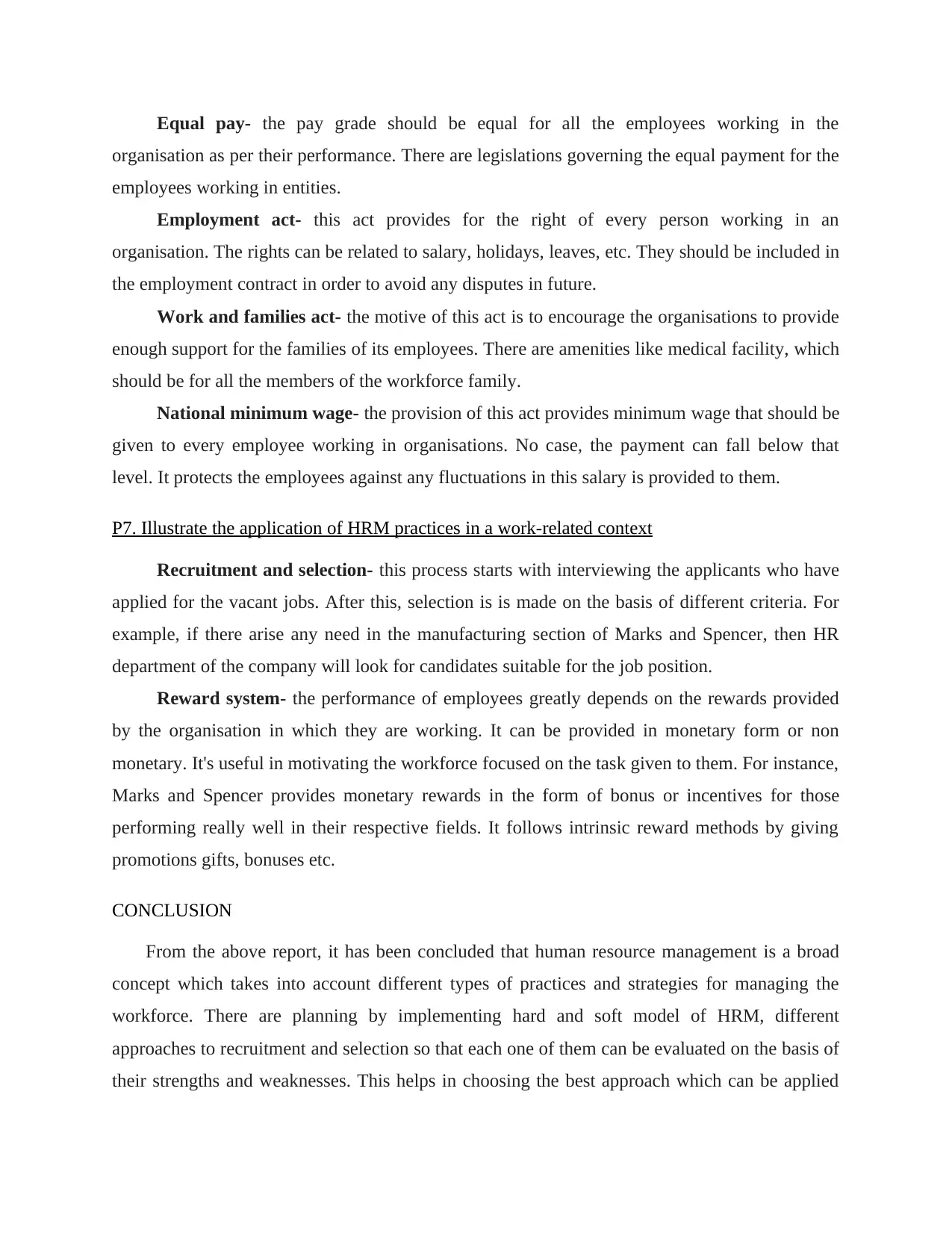
Equal pay- the pay grade should be equal for all the employees working in the
organisation as per their performance. There are legislations governing the equal payment for the
employees working in entities.
Employment act- this act provides for the right of every person working in an
organisation. The rights can be related to salary, holidays, leaves, etc. They should be included in
the employment contract in order to avoid any disputes in future.
Work and families act- the motive of this act is to encourage the organisations to provide
enough support for the families of its employees. There are amenities like medical facility, which
should be for all the members of the workforce family.
National minimum wage- the provision of this act provides minimum wage that should be
given to every employee working in organisations. No case, the payment can fall below that
level. It protects the employees against any fluctuations in this salary is provided to them.
P7. Illustrate the application of HRM practices in a work-related context
Recruitment and selection- this process starts with interviewing the applicants who have
applied for the vacant jobs. After this, selection is is made on the basis of different criteria. For
example, if there arise any need in the manufacturing section of Marks and Spencer, then HR
department of the company will look for candidates suitable for the job position.
Reward system- the performance of employees greatly depends on the rewards provided
by the organisation in which they are working. It can be provided in monetary form or non
monetary. It's useful in motivating the workforce focused on the task given to them. For instance,
Marks and Spencer provides monetary rewards in the form of bonus or incentives for those
performing really well in their respective fields. It follows intrinsic reward methods by giving
promotions gifts, bonuses etc.
CONCLUSION
From the above report, it has been concluded that human resource management is a broad
concept which takes into account different types of practices and strategies for managing the
workforce. There are planning by implementing hard and soft model of HRM, different
approaches to recruitment and selection so that each one of them can be evaluated on the basis of
their strengths and weaknesses. This helps in choosing the best approach which can be applied
organisation as per their performance. There are legislations governing the equal payment for the
employees working in entities.
Employment act- this act provides for the right of every person working in an
organisation. The rights can be related to salary, holidays, leaves, etc. They should be included in
the employment contract in order to avoid any disputes in future.
Work and families act- the motive of this act is to encourage the organisations to provide
enough support for the families of its employees. There are amenities like medical facility, which
should be for all the members of the workforce family.
National minimum wage- the provision of this act provides minimum wage that should be
given to every employee working in organisations. No case, the payment can fall below that
level. It protects the employees against any fluctuations in this salary is provided to them.
P7. Illustrate the application of HRM practices in a work-related context
Recruitment and selection- this process starts with interviewing the applicants who have
applied for the vacant jobs. After this, selection is is made on the basis of different criteria. For
example, if there arise any need in the manufacturing section of Marks and Spencer, then HR
department of the company will look for candidates suitable for the job position.
Reward system- the performance of employees greatly depends on the rewards provided
by the organisation in which they are working. It can be provided in monetary form or non
monetary. It's useful in motivating the workforce focused on the task given to them. For instance,
Marks and Spencer provides monetary rewards in the form of bonus or incentives for those
performing really well in their respective fields. It follows intrinsic reward methods by giving
promotions gifts, bonuses etc.
CONCLUSION
From the above report, it has been concluded that human resource management is a broad
concept which takes into account different types of practices and strategies for managing the
workforce. There are planning by implementing hard and soft model of HRM, different
approaches to recruitment and selection so that each one of them can be evaluated on the basis of
their strengths and weaknesses. This helps in choosing the best approach which can be applied
Secure Best Marks with AI Grader
Need help grading? Try our AI Grader for instant feedback on your assignments.

within the organisation. Followed by this, where HRM is practices such as recruitment, reward
system and so on evaluated for determining the benefits. Furthermore, significance of employee
relation is there which have the capabilities to affect the decision making of HR manager. Along
with this, there are different kinds of legislation which are applicable to the company and
compliance with them is necessary in order to avoid any legal consequences.
system and so on evaluated for determining the benefits. Furthermore, significance of employee
relation is there which have the capabilities to affect the decision making of HR manager. Along
with this, there are different kinds of legislation which are applicable to the company and
compliance with them is necessary in order to avoid any legal consequences.
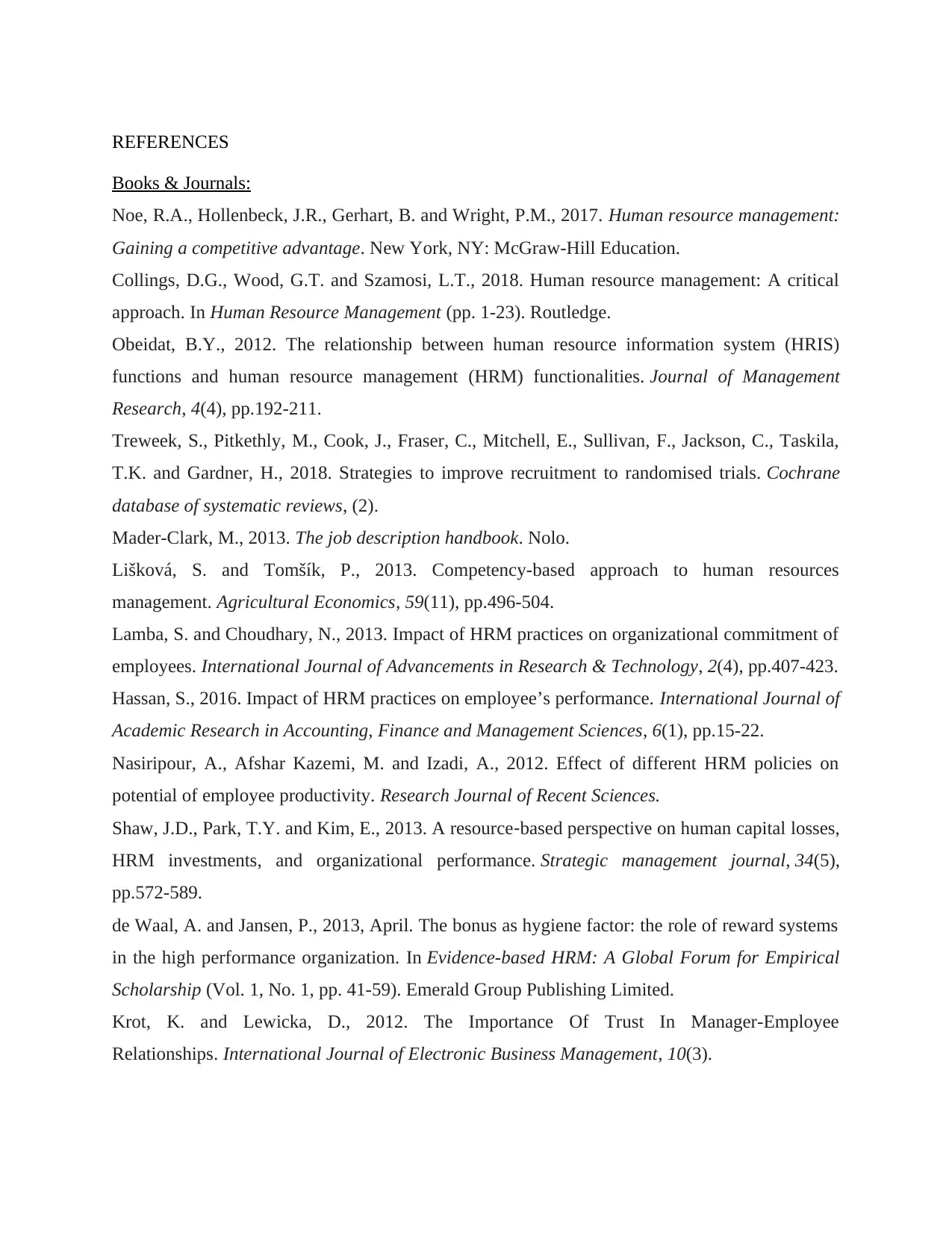
REFERENCES
Books & Journals:
Noe, R.A., Hollenbeck, J.R., Gerhart, B. and Wright, P.M., 2017. Human resource management:
Gaining a competitive advantage. New York, NY: McGraw-Hill Education.
Collings, D.G., Wood, G.T. and Szamosi, L.T., 2018. Human resource management: A critical
approach. In Human Resource Management (pp. 1-23). Routledge.
Obeidat, B.Y., 2012. The relationship between human resource information system (HRIS)
functions and human resource management (HRM) functionalities. Journal of Management
Research, 4(4), pp.192-211.
Treweek, S., Pitkethly, M., Cook, J., Fraser, C., Mitchell, E., Sullivan, F., Jackson, C., Taskila,
T.K. and Gardner, H., 2018. Strategies to improve recruitment to randomised trials. Cochrane
database of systematic reviews, (2).
Mader-Clark, M., 2013. The job description handbook. Nolo.
Lišková, S. and Tomšík, P., 2013. Competency-based approach to human resources
management. Agricultural Economics, 59(11), pp.496-504.
Lamba, S. and Choudhary, N., 2013. Impact of HRM practices on organizational commitment of
employees. International Journal of Advancements in Research & Technology, 2(4), pp.407-423.
Hassan, S., 2016. Impact of HRM practices on employee’s performance. International Journal of
Academic Research in Accounting, Finance and Management Sciences, 6(1), pp.15-22.
Nasiripour, A., Afshar Kazemi, M. and Izadi, A., 2012. Effect of different HRM policies on
potential of employee productivity. Research Journal of Recent Sciences.
Shaw, J.D., Park, T.Y. and Kim, E., 2013. A resource‐based perspective on human capital losses,
HRM investments, and organizational performance. Strategic management journal, 34(5),
pp.572-589.
de Waal, A. and Jansen, P., 2013, April. The bonus as hygiene factor: the role of reward systems
in the high performance organization. In Evidence-based HRM: A Global Forum for Empirical
Scholarship (Vol. 1, No. 1, pp. 41-59). Emerald Group Publishing Limited.
Krot, K. and Lewicka, D., 2012. The Importance Of Trust In Manager-Employee
Relationships. International Journal of Electronic Business Management, 10(3).
Books & Journals:
Noe, R.A., Hollenbeck, J.R., Gerhart, B. and Wright, P.M., 2017. Human resource management:
Gaining a competitive advantage. New York, NY: McGraw-Hill Education.
Collings, D.G., Wood, G.T. and Szamosi, L.T., 2018. Human resource management: A critical
approach. In Human Resource Management (pp. 1-23). Routledge.
Obeidat, B.Y., 2012. The relationship between human resource information system (HRIS)
functions and human resource management (HRM) functionalities. Journal of Management
Research, 4(4), pp.192-211.
Treweek, S., Pitkethly, M., Cook, J., Fraser, C., Mitchell, E., Sullivan, F., Jackson, C., Taskila,
T.K. and Gardner, H., 2018. Strategies to improve recruitment to randomised trials. Cochrane
database of systematic reviews, (2).
Mader-Clark, M., 2013. The job description handbook. Nolo.
Lišková, S. and Tomšík, P., 2013. Competency-based approach to human resources
management. Agricultural Economics, 59(11), pp.496-504.
Lamba, S. and Choudhary, N., 2013. Impact of HRM practices on organizational commitment of
employees. International Journal of Advancements in Research & Technology, 2(4), pp.407-423.
Hassan, S., 2016. Impact of HRM practices on employee’s performance. International Journal of
Academic Research in Accounting, Finance and Management Sciences, 6(1), pp.15-22.
Nasiripour, A., Afshar Kazemi, M. and Izadi, A., 2012. Effect of different HRM policies on
potential of employee productivity. Research Journal of Recent Sciences.
Shaw, J.D., Park, T.Y. and Kim, E., 2013. A resource‐based perspective on human capital losses,
HRM investments, and organizational performance. Strategic management journal, 34(5),
pp.572-589.
de Waal, A. and Jansen, P., 2013, April. The bonus as hygiene factor: the role of reward systems
in the high performance organization. In Evidence-based HRM: A Global Forum for Empirical
Scholarship (Vol. 1, No. 1, pp. 41-59). Emerald Group Publishing Limited.
Krot, K. and Lewicka, D., 2012. The Importance Of Trust In Manager-Employee
Relationships. International Journal of Electronic Business Management, 10(3).
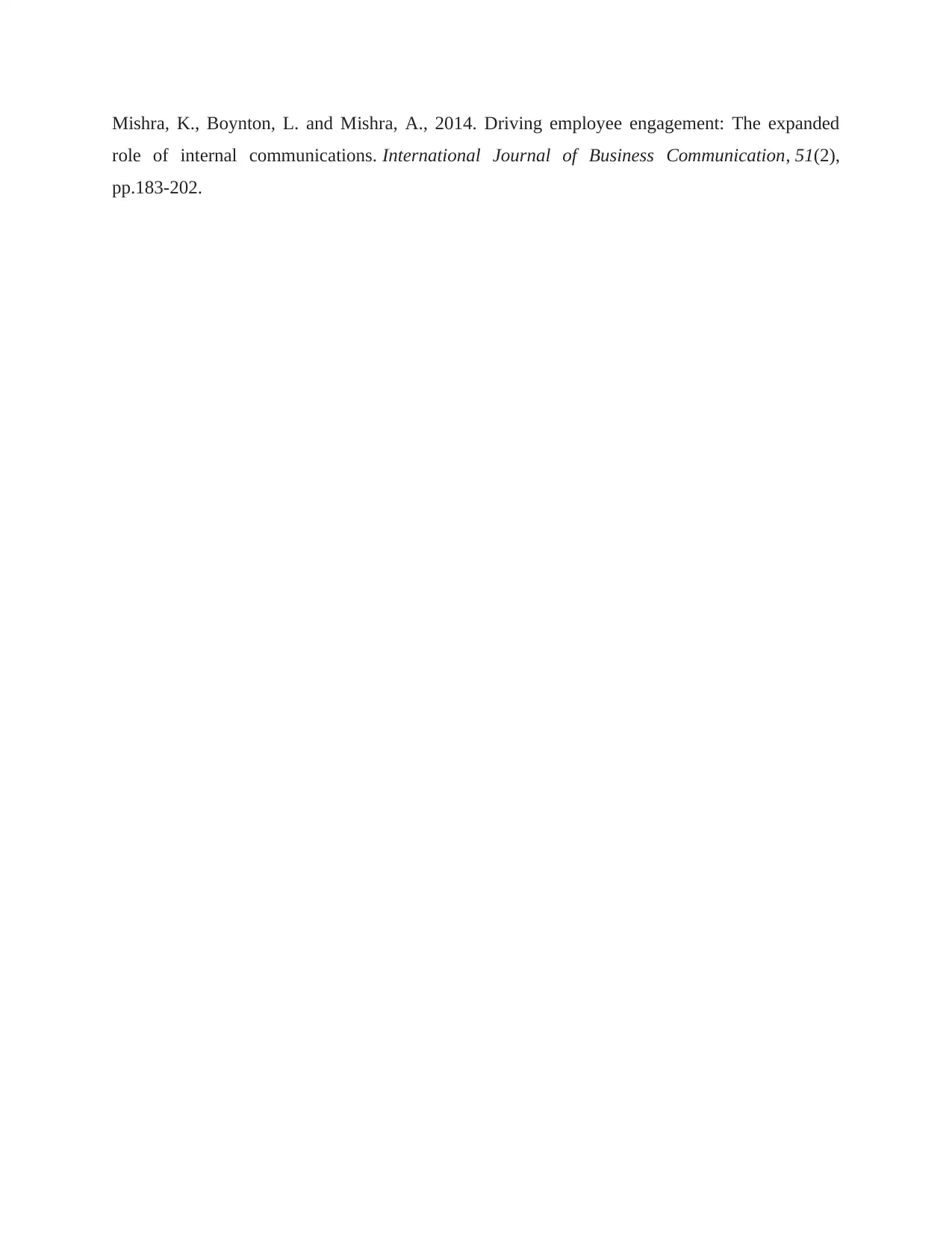
Mishra, K., Boynton, L. and Mishra, A., 2014. Driving employee engagement: The expanded
role of internal communications. International Journal of Business Communication, 51(2),
pp.183-202.
role of internal communications. International Journal of Business Communication, 51(2),
pp.183-202.
1 out of 13
Related Documents
Your All-in-One AI-Powered Toolkit for Academic Success.
+13062052269
info@desklib.com
Available 24*7 on WhatsApp / Email
![[object Object]](/_next/static/media/star-bottom.7253800d.svg)
Unlock your academic potential
© 2024 | Zucol Services PVT LTD | All rights reserved.





